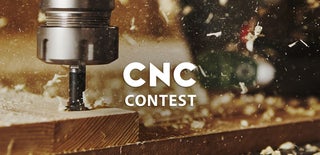Introduction: Google Maps for CNC Projects
This instructable shows how I was able to create a CNC cut map of my town in a quick and affordable way. The workflow I describe is very general and can be used to create any sized map of any city in the world.
Step 1: Step 1: Make an SVG File Using Google Maps
There are many ways to create SVG files. The method I used was to take a screenshot of the area I wanted to make a map of. I loaded the image into the free software Inkscape and used the background to add points outlining the streets and river. After I was finished, I removed the background image and was able to view just the lines from the SVG file.
Step 2: Step 2: Generate a CNC Cut Path
Once the SVG has been created, it needs to be converted into a CNC readable file (usually .nc or .gcode). There are some very good programs that each have their pros and cons. Historically, I've used MakerCAM.com because it's very simple and convenient to use but the generated file included too many z-axis plunges and a lot of necessary travel time.
Instead, I used the free version of Autodesk Fusion 360 to generate a cut file. The initial results were good enough for a one-off CNC cut. It is fairly easy to add the SVG and extrude it into a solid block of material in Fusion 360. The milling tab then allows the user to set the cut depths, tools, speeds, and many other CNC settings. After finishing the settings, the cut path can be simulated and used to generate a CNC readable file.
Step 3: Step 3: Pick Out Material
Once I had the design ready, I went to buy a pick of wood to cut. I choose a 2'x4'x0.5'' piece of plywood from Low's and scaled the SVG accordingly. The total cost of the wood was ~$15.
Step 4: Step 4: Cut the Material
About two years ago I bought the Maslow CNC. I used it in this project to cut the design. Initially, everything went well with the 1/8'' bit I was using. When I moved to the river, I switched to a 1/2'' bit and cut to a depth of 0.25''. I started having problems because my cut speed was a bit too fast for the amount of material I was removing and it showed in the cut. In future runs, I plan to slow down a bit more. The entire cut took 2 hours and 3 minutes (1 hour 40 minutes of cutting) and removed about 15% of the initial material.
Step 5: Step 5: Finish and Display
I spray painted the entire piece black and sanded the top surface until it had a heathered look. I was then able to hang it up in my house.

Participated in the
CNC Contest 2020







